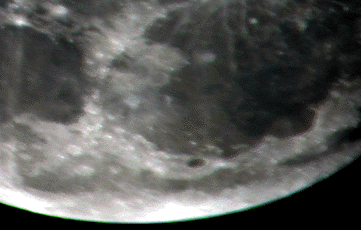it’s great fun, and here is our brilliant picture of the moon…well, actually it’s three pictures (one red, one blue and one green) on top of each other thanks to Adobe Photoshop.
THIS IS THE MOON (and don’t tell us you wouldn’t have guessed that):

Don cha like it, eh? It took us a long time, but that was due to a few focusing difficulties.
The large dark area on the right is the Mare Imbrium, and the smaller dark area on the left is the Mare Serenitatis.
The dark crater just below Mare Imbrium is called Plato, and the bright lines which snake into Mare Imbrium from the top of the photo are ejecta rays from the large crater called Copernicus.
The light colored areas of the Moon are the lunar highlands. They are mostly composed of a light-colored rock called anorthosite. (Anorthosite is a rock made up almost entirely of calcium-plagioclase feldspar.) The dark areas on the moon are the lowland plains. They are made up of dark-colored flood basalts (composed mostly of pyroxenes, plagioclase feldspars, and some olivine, amphiboles, and mica).
That’s Brian the geo major speaking. Another thing that’s still geo but not so geo-y is that the lighter areas in the moon are older than the darker areas. When the moon was first created out of HOT HOT HOT rock, the calcium-plagioclase (a type of rock that is lighter–I always remember that because milk is white and has calcium in it) “floated” to the top because it was less dense. This crust cooled and melted. Then meteors crashed into the moon and allowed the rock beneath it, which was more dense and also darker (2 facts not related), to “show,” thus we see this darker color. So
LIGHT=OLD
DARK=NEW(er…we’re talkin the moon now)
Here’s the star that we used to try and focus the durn thing:

ain’t it purdy?? “x-site-ting” is what brian says. It doesn’t look perfectly circular because it’s not quite focused. Can you tell which star it is, oh you astronomy buffs? It’s in the constellation Corvus.